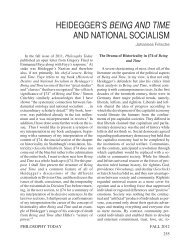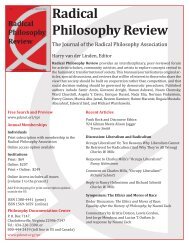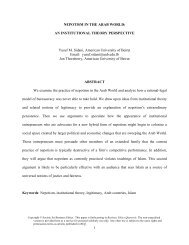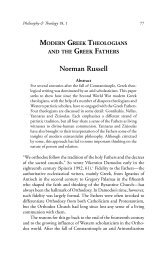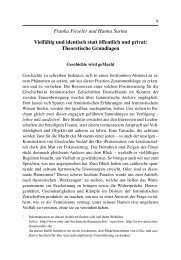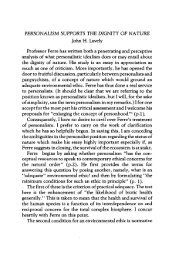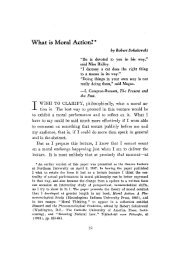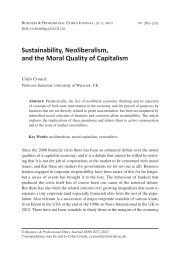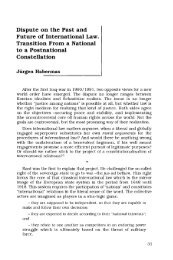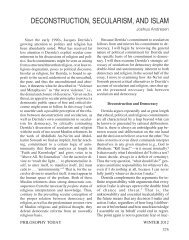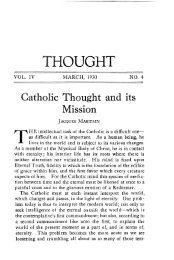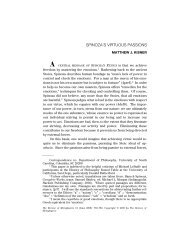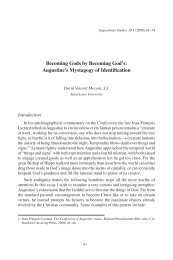The Essay as Self-Knowledge: Montaigne's Philosophical ...
The Essay as Self-Knowledge: Montaigne's Philosophical ...
The Essay as Self-Knowledge: Montaigne's Philosophical ...
You also want an ePaper? Increase the reach of your titles
YUMPU automatically turns print PDFs into web optimized ePapers that Google loves.
82 ANN HARTLE<br />
“Montaigne and the Mirror of Example,” Philosophy and Literature 13 (1989):<br />
5, cites the change Montaigne makes in the story about the man from Delos.<br />
17. See Quint, Quality of Mercy, 40. In connection with Epaminond<strong>as</strong> see<br />
Marcel Gutwirth, “‘By Diverse Means . . .’ (I: 1),” Yale French Studies 64<br />
(1983): 182, 186.<br />
18. Patrick Henry, “<strong>The</strong> Rise of the <strong>Essay</strong>: Montaigne and the Novel,”<br />
Montaigne Studies 6 (1994): 124–25: the Essais are neither history nor fiction<br />
but share attributes of both.<br />
19. On the necessity of Montaigne’s disorder, see Jean-Yves Pouilloux,<br />
Montaigne l‘éveil de la pensée (Paris: Editions Champion, 1995), esp. 53, 56,<br />
96; Jules Brody, “Les Oreilles de Montaigne,” Romanic Review 74 (1983):<br />
124; Margaret McGowan, “<strong>The</strong> Art of Transition in the Essais,” in Montaigne:<br />
<strong>Essay</strong>s in Memory of Richard Sayce, ed. I. D. McFarlane and Ian Maclean<br />
(Oxford: Clarendon Press, 1982), 37.<br />
20. See Marianne S. Meijer, “De l’honnête, de l’utile et du repentir,” Journal<br />
of Medieval and Renaissance Studies 12, no. 2 (1982): 259–74, for a discussion<br />
the unity of essays III.1, 2, and 3.<br />
21. P<strong>as</strong>cal, Pensées, Br. no. 62.<br />
22. Edouard Ruel, Du Sentiment artistique dans la morale de Montaigne<br />
(Paris: Librairie Hachette, 1901), 38, contr<strong>as</strong>ts Montaigne’s poetic order with<br />
scientific order. Gray, Le Style, refers to Montaigne’s “interior order” (206);<br />
he places himself at the interior of a poetic or philosophic image (210–11).<br />
Richard M. Chadbourne, “Michel de Montaigne,” in Tracy Chevalier, ed., Encyclopedia<br />
of the <strong>Essay</strong> (London and Chicago: Fitzroy Dearborn Publishers,<br />
1997), 570, claims that Montaigne “intended his own prose to be moved by a<br />
similar ‘demon’ [to Plato’s].” Philippe Desan, Naissance de la Méthode (Paris:<br />
Librairie A.G. Nizet, 1987), 127, also refers to Montaigne’s “internal order.”<br />
Montaigne’s method is “une pratique du quotidien,” and the “everyday” h<strong>as</strong> a<br />
logic that is not obvious.<br />
23. Richard L. Regosin, “Sources and Resources: <strong>The</strong> ‘Pretexts’ of Originality<br />
in Montaigne’s Essais,” Sub-Stance 21 (1978): 110, claims that the<br />
<strong>Essay</strong>s “undermine notions of external origin.” For Lukacs, Soul and Form,<br />
11: “the essay h<strong>as</strong> to create from within itself all the preconditions for the<br />
effectiveness and validity of its vision.” O. B. Hardison, “Binding Proteus:<br />
An <strong>Essay</strong> on the <strong>Essay</strong>,” in <strong>Essay</strong>s on the <strong>Essay</strong>: Redefining the Genre, ed.<br />
Alexander J. Butrym (Athens, Ga.: University of Georgia Press, 1989), 26,<br />
characterizes the essay <strong>as</strong> “thought thinking about itself.” Peter Burke,<br />
Montaigne (Oxford: Oxford University Press, 1981), 62, refers to “the<br />
author’s attempt to catch himself in the act of thinking.” Sayce, Critical<br />
Exploration, 104, describes the order of the essays <strong>as</strong> the order of “spontaneous<br />
thought.” What emerges is a sense of mystery, a “labyrinth” (322–<br />
23). Gustave Lanson, Les Essais de Montaigne (Paris: Librairie Mellottee<br />
[1947?]), 316–17, also notes the spontaneity of the form. Montaigne rejects



